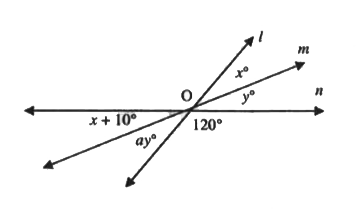If is the line whose equation is ax+by=c. Let M be the reflection of 'L through the y-axis and let N be the reflection of L through the x-axis. Which of the following must be true about M and N for choices of a,b and c?
Step by step video & image solution for If is the line whose equation is ax +by=c. Let M be the reflection of 'L through the y-axis and let N be the reflection of L through the x-axis. Which of the following must be true about M and N for choices of a, b and c? by Maths experts to help you in doubts & scoring excellent marks in Class 12 exams.
Updated on:21/07/2023Similar Questions
If C is the reflection of A(2,4) in x-axis and B is the reflection of C in y-axis then |AB| is 4√k then k=
View SolutionLet P be the point (3, 2). Let Q be the reflection of P about the x-axis. Let R be the reflection of Q about the line y=−x and let S be the reflection of R through the origin, PQRS is a convex quadrilateral . Find the area of PQRS.
View Solution
Knowledge Check
In the figure, lines l, m and n intersect at O. Which one of the following must be true about the value of a?
 Aa<5/8Ba=5/7Ca=5/6Da=1
Aa<5/8Ba=5/7Ca=5/6Da=1If C is the reflection of A (2,4) in X-axis and B is the reflection of C in Y-axis, then |AB| is equal to
A20B2√5C4√5D4
Let P be the point (3, 2). Let Q be the reflection of P about the x-axis. Let R be the reflection of Q about the line y=−x and let S be the reflection of R through the origin, PQRS is a convex quadrilateral . Find the area of PQRS.
View SolutionLet m,n are integers with 0<n<m. A is the point (m,n) on the Cartesian plane. B is the reflection of A in the line y=x. C is the reflection of B in the y-axis, D is the reflection of C in the x-axis and E is the reflection of D in the y-axis. The area of the pentagon ABCDE is
a.2m(m+n) b. m(m+3n) c. m(2m+3n) d. 2m(m+3n)
View SolutionLet m,n are integers with 0<n<m. A is the point (m,n) on the Cartesian plane. B is the reflection of A in the line y=x. C is the reflection of B in the y-axis, D is the reflection of C in the x-axis and E is the reflection of D in the y-axis. The area of the pentagon ABCDE is 2m(m+n) b. m(m+3n) c. m(2m+3n) d. 2m(m+3n)
View SolutionLet m,n are integers with 0<n<m. A is the point (m,n) on the Cartesian plane. B is the reflection of A in the line y=x. C is the reflection of B in the y-axis. D, is the reflection of C in the x-axis and E is the reflection of D in the y-axis. The area of the pentagon ABCDE is 2m(m+n) (b) m(m+3n) m(2m+3n) (d) 2m(m+3n)
View SolutionLet m,n are integers with 0<n<m. A is the point (m,n) on the Cartesian plane. B is the reflection of A in the line y=x. C is the reflection of B in the y-axis. D, is the reflection of C in the x-axis and E is the reflection of D in the y-axis. The area of the pentagon ABCDE is 2m(m+n) (b) m(m+3n) m(2m+3n) (d) 2m(m+3n)
View SolutionConsider a point A(m,n) , where m and n are positve intergers. B is the reflection of A in the line y=x, C is the reflaction of B in the y axis, D is the reflection of C in the x axis and E is the reflection of D is the y axis. The area of the pentagon ABCDE is a. 2m(m+n) b. m(m+3n) c. m(2m+3n) d. 2m(m+3n)
View Solution
